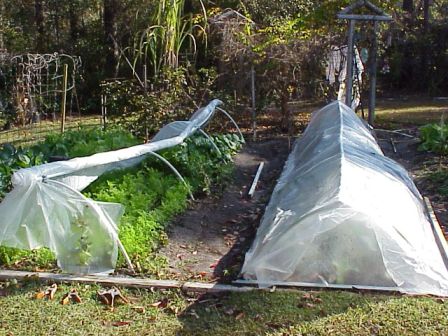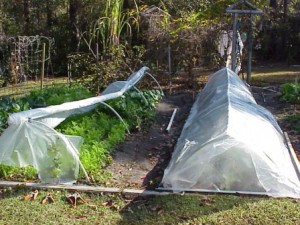
What To Do Before and After a Hard Freeze
Florida homeowners enjoy a wide range of landscape and citrus plants and often times desire a tropical or semitropical appearance to their landscapes. Many landscape plants are often planted past their northern limit such as here in Northwest Florida, although microclimates differ dramatically. Tropical and subtropical plants can be used in the landscape, but they must be protected or replaced if necessary during cold weather. A good variety of tender and hardy plants should be planted in order to prevent total devastation of the landscape by extremely cold weather.
The site selection for tender plants should be number one on your list when preparing for a freeze. Tender ornamental plants need a higher site with good air drainage, and not in a low area where cold air settles. Arranging tender plants along fences or other barriers to protect them from cold winds improves the plants’ cold protection, especially from very hard freezes.
Poorly drained soils result in weak shallow roots which are more susceptible to cold injury. Plants grown with the correctly applied rate of nutrients will tolerate colder temperatures better and recover from cold injury faster than plants grown with little or no added nutrients. Be aware that late fall fertilizing of nutrient deficient plants or fertilization before unseasonably warm periods can result in a late growth which is more susceptible to cold injury.
Ornamental plants that are planted under large tree canopies can have more cold protection and require less cold prevention for the owner.
Watering landscape plants before a freeze can help protect plants. A well watered soil will absorb more solar radiation than dry soil and will reradiate heat during the night by as much as 2°F . However, saturated soil conditions can damage the root systems of most plants over a few days, so make sure the ground is well drained.
Avoid late summer or early fall pruning which can alter the plant hormonal balance resulting a flush of new growth. This new growth is more susceptible to cold injury. Healthy plants are more resistant to cold than plants weakened by disease, insect damage, or nematode damage. Routine inspection for pests and implementation of necessary control measures are essential.
Here are a few methods for plant protection. Plants in pots or containers must be moved indoors where heat can be available to them. Containers that have to be left outdoors should be protected by mulches around the container or root ball of plants in the landscape to reduce heat loss from container sidewalls.

Cold Protection for Veggies!
Coverings can help protect plants more from frost than from extreme cold. Covers that extend to the ground and are not in contact with plant foliage can lessen cold injury to the plant. Foliage in contact with the cover is often cold burned or injured because of heat transfer from the foliage to the colder cover. Some examples of excellent plant covers are cloth sheets, quilts or black plastic. If plastic covering is used, it is extremely important to remove the covering during the day to provide ventilation of trapped heat. A light bulb under a covering also is a simple method of providing heat to ornamental plants in the landscape during the night hours. Cold Damage on Fruit Tree
Cold Damage on Fruit Tree
Pictures By Eddie Powell
Immediately after the frigid weather has passed, plants need to be checked for water loss. The foliage could be losing water vapor or transpiring on a sunny day after a freeze while water in the soil or container medium is frozen. Apply water to thaw the soil and provide available water for the plant. Soils or media with high soluble salts should not be allowed to dry out because salts would be concentrated into a small volume of water and can burn plant roots. Root burn can cause the roots to dry out and not take up water to the plant.
Pruning should be delayed until freezing temperatures have risen or until new growth appears to ensure that live wood is not removed. Dead, unsightly leaves may be removed as soon as they turn brown after a freeze if a high level of maintenance is desired. But it is best to wait until the threat of freezing weather is gone. Cold injury may appear as a lack of spring bud break on a portion or all of the plant, or as an overall weak appearance. Cold injury is usually found in the upper portion of the plant. Branch tips may be damaged while older wood underneath is free of injury. Cold injured wood can be identified by examining the cambium layer under the bark for black or brown coloration. Prune these branches back to a bud 2-3 inches behind the point of discoloration.
For more information on freeze protection of plants see:
Cold Protection of Landscape Plants
